Genre: Puzzle Developer: Audiogenic Software Ltd. Publisher: Flying Edge Players: 1 Released: 1992
You couldn’t swing a dead cat in the late eighties without hitting something with the Simpsons name on it. Seemingly overnight, stores were inundated with merchandise trying to capitalize on FOX’s runaway hit. It was naturally only a matter of time before the animated family started showing up in video games. Most of these were trite, soulless efforts that managed neither to capture the essence of the source material or even be particularly fun (your quintessential licensed game, in other words). Somewhere along the line, however, someone got the idea for Krusty’s Super Fun House, a title that separated itself from its companions with its puzzle-oriented gameplay and the redirection of focus from any of the central Simpson family members. With Bart and Homer regulated to cameo status and virtually nothing conceptually in common with the show, KSFH certainly doesn’t overwhelm players with its license. Despite a serious Simpson deficiency, however, there’s no denying that this is a genuinely fun and clever little game worthy of your attention.
The concept of KSFH is summed up quite succinctly by Krusty himself at the start of the game. Annoying rats have infested Krusty’s fun house (which is super, I’ve heard) and are wreaking havoc by marching aimlessly back and forth. This unspeakable threat can only be countered by leading the rats to a number of traps operated by more traditional Simpsons characters like Bart, Homer, and Sideshow Mel. Once the rats have been lured into these death machines, they are ceremoniously exterminated. Each of the five sections of the fun house contain about a dozen rooms. Once cleared, a room is locked up, preventing future entry. You can access most of the rooms in any order you please, but all of them must be properly fumigated before progressing to the next section.
This isn’t the first game to feature marching rodents as its central gameplay mechanic, but comparisons to Lemmings end there. Unlike Lemmings, in which you use the titular characters to interact with the environment, in KSFH you use the environment to interact with the rats. As Krusty, you manipulate the rats’ progress by strategically placing blocks to act as stepping stones or barricade them off from certain areas. Later levels have you piecing together snaking pipe sections or trapping the rats in jars so you can carry them or use them as blocks themselves. The even balance of platforming and puzzle elements makes for an experience that is at once intuitively familiar and refreshingly original.
Krusty runs and jumps with great agility through the surprisingly expansive rooms and can equip himself with pies and bouncing superballs to dispatch enemies like flying pigs, snakes, and laser-shooting aliens (aliens, Krusty? And you’re worried about a bunch of stupid rats?!). Exploration is a key factor in the game, as you must often go out of your way to find the tools for each room’s solution. You can also stack blocks and break down certain walls with superballs to find secret areas containing goodies like pies, health upgrades, and a number of score-enhancing collectibles. Krusty’s fun house and its occupants look great. The graphics are clean and colorful, and character sprites are quite faithful to characters from the show. Krusty is animated smoothly and expressively; grinning incessantly at you as he runs through the levels or panting wearily when he’s close to collapse. The traps are definitely worth a look, as the rats are given some interesting deaths like being vaporized by Homer, eaten by Corporal Punishment or blown up Dig Dug-style by Sideshow Mel. The music and sound effects, on the other hand, are simply awful. One would do well to turn the volume way down before even turning the game on.
With sparse backgrounds and environments, the game definitely walks a fine line between charming modesty and stagnant, visual constipation. Fortunately, the focal point in each room is the puzzle, and most of these are cleverly (even deviously) designed. The fact that most rooms are so large and have more than one solution keeps the game feeling fresh and innovative. An easy-to-remember password is given after each section is completed, although in most cases the passwords cannot come soon enough.
The most noticeable problem with KSFH is that there are only five sections, which unfortunately limits the variations in both the environments and the rat traps. Also, as each section is made up of about fifteen individual levels, getting a password can be a rather strenuous process. Although Krusty can be killed by too many hits from enemies or falling too far, loss of life will more often stem from failure to clear rooms. Some puzzles must be completed a certain way and require more trial and error than any real ingenuity, and chasing down the wrong solution is often irrevocable, forcing you to cancel out of the room at the expense of one of your lives. While I appreciate the added challenge, it’s not uncommon to get through thirteen of the fourteen rooms only to run out of lives in the last room and have to start completely over at the start of the section. Providing an additional password halfway through each section could have alleviated some of this frustration. Also, a bit more variety could have been used in the traps themselves. Seeing the same trap for nearly fifteen straight levels gets old fairly quickly.
Krusty’s Super Funhouse is a perfect example of a licensed game strong enough to warrant success on its own merits. The Simpsons license is applied so superficially here, I can’t help but wonder why they used it at all. It could easily have been Bozo’s Super Fun House, or even Mario’s Super Fun House on another system (some might argue that this latter game in fact exists in the form of the Mario vs. DK series). An overall lack of variation in in level aesthetics and rat trap designs hint at a little more time needed in the production schedule and asking players to grind through nearly fifteen puzzles before providing them with a password is a bit much. Still, the delectable balance of action and puzzle elements make for an addictive and wholly charming game that benefits only slightly from a Simpsons motif.
SCORE: 7 out of 10


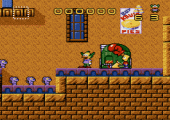
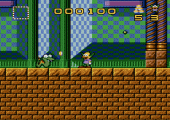
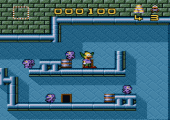
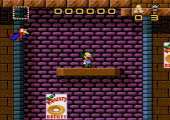
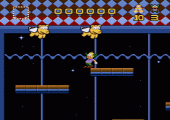
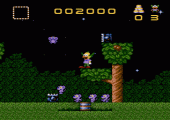
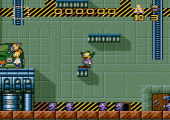
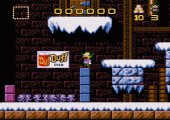
Recent Comments